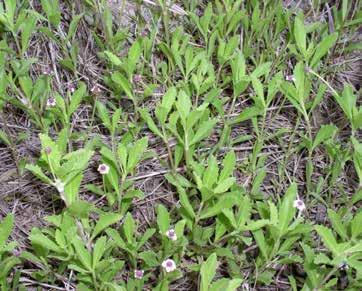
2 minute read
Plant Profile
Texas Frogfruit
Article and photos by RICKY LINEX
New growth of frogfruit spreads by initiating growth in spring with new leaves and stolon growth.
Flowers are visited by many species of butterflies, native bees and European honey bees.
If a native plant is low-growing, tends to run across the ground at ground level and has tiny flowers overshadowed by taller plants, perhaps it must rely upon its name for recognition. Texas frogfruit might be such a plant.
Like many other native plants in Texas, frogfruit has a few unique alternative names as well including fogfruit, frogfruit and sawtooth fogfruit. Perhaps the most interesting alternative name is turkey tangle fogfruit, often abbreviated to turkey tangle. An early botanist saw what he thought was a turkey tangled up but all that was seen in the area was frogfruit.
With prostrate, four-angled stems, frogfruit, Phyla nodiflora, creeps along the ground, rooting at the nodes, branching and forming dense mats several feet in diameter. This native, perennial, warm-season plant rises only 3-5 inches above the ground but may have runners up to 3 feet long. Under irrigation in a flower bed these runners can approach 5-6 feet in length and are quite breathtaking when cascading down a ledge rock wall or rock landscaping.
The opposite or clustered leaves are spatula-shaped or oblong with a wedge-shaped base. The leaves are thick, 1-2 inches long and 5/8-inch wide and toothed from middle to tip of the leaf. Numerous flower heads appear at first rounded but elongating to a 1¼-inch long cylinder, up to 3/8-inch wide and growing on separate stalks each up to 4 inches long.
Flowers are tiny, white with yellow centers consisting of four lobes that usually have a tiny notch in the tip of each lobe. Each flower is no larger than a wooden matchhead. The flowers form a ring around the elongating flower head near the tip. As the flower head matures, it lengthens, and a new ring of flowers is formed. From May through October, every 7-10 days a new row of tiny flowers emerge from the flowerhead awaiting a visit from pollinators.
The leaves of frogfruit are used as forage by livestock and provide fair value forage for deer. Frogfruit is considered a desirable colonizer plant in riparian areas alongside creeks and rivers, helping to provide an initial mat of roots on fresh sediment deposits.
These stolons root down at every node along the stems helping to hold the soil in place. As these stolons grow outward, they often form what appears to be a netting upon the ground. The long-flowering period of this plant is especially well-liked and visited by several species of butterflies.
Frogfruit can be found in all 10 vegetational regions of Texas. In upland sites, frogfruit can usually be found near along the margins of ponds or within slight depressions of just a few inches in rangeland pastures which gives the plant favorable soil moisture conditions. Growing so near to the ground, frogfruit thrives in areas with little competition from other vegetation.






